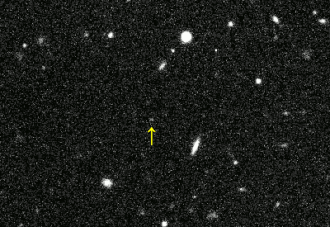Jupiter LXIX
 Discovery images of Jupiter LXIX from the Cerro Tololo Observatory's Dark Energy Camera on 23 March 2017 | |
| Discovery | |
|---|---|
| Discovered by | Scott Sheppard et al. |
| Discovery date | 2017 |
| Designations | |
Designation | Jupiter LXIX |
| S/2017 J 8 | |
| Orbital characteristics [1] | |
| 23232700 km | |
| Eccentricity | 0.312 |
| −719.6 days | |
| 70.8° | |
| Inclination | 164.7° |
| 160.3° | |
| 45.1° | |
| Satellite of | Jupiter |
| Group | Carme group |
| Physical characteristics | |
| 1 km | |
| 24.0 | |
Jupiter LXIX, originally known as S/2017 J 8, is an outer natural satellite of Jupiter. It was discovered by Scott S. Sheppard and his team in 2017, but not announced until July 17, 2018, via a Minor Planet Electronic Circular from the Minor Planet Center.[2] It is about 1 kilometer in diameter and orbits at a semi-major axis of about 23,232,700 km with an inclination of about 164.7°.[3] It belongs to the Carme group.

References
- ^ S.S. Sheppard (2019), Moons of Jupiter, Carnegie Science, on line
- ^ "MPEC 2018-O16 : S/2017 J 8". Minor Planet Center. International Astronomical Union. Retrieved 17 July 2018.
- ^ "Archived copy". Archived from the original on 2017-07-20. Retrieved 2018-07-17.
{{cite web}}: CS1 maint: archived copy as title (link)